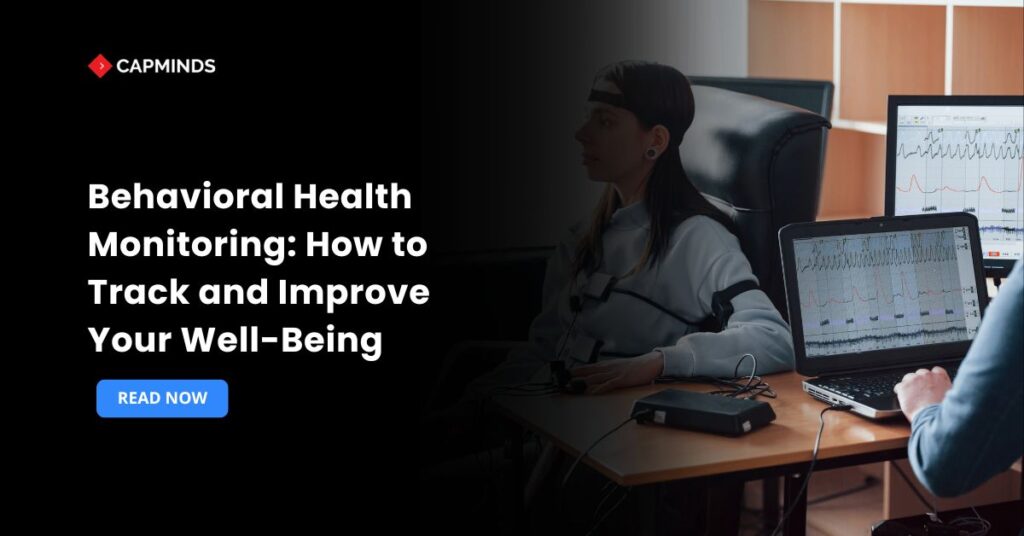Behavioral Health Monitoring: How to Track and Improve Your Well-Being
Modern life is very demanding, and as a result, chronic stress and increasing emotional loads may pass unnoticed, resulting in a silent crisis.
The problem is that such symptoms of mental distress and changes in behavior are slow to develop, and it is incredibly difficult to take action before a crisis occurs.
Absence of early detection allows small problems to spread into serious mental health problems, affecting work and physical health. There is a strong method of taking control back and building resilience: the methodical process of behavioral health monitoring.
This guide will help you effectively adopt behaviors and use technology to manage, monitor, and maintain your emotional and psychological well-being and provide mental health solutions for a stable and satisfying life.
What is Behavioral Health Monitoring?
Behavioral health monitoring is the continuous, systematic monitoring of an individual’s emotional status, cognitive functions, and observable behavior to identify trends, potential risks, and the efficacy of treatment interventions. It goes beyond intermittent check-ins by producing a live stream of the psychological well-being of a person.
Just imagine it as a kind of psychological monitoring of vital signs such as blood pressure and heart rate. As the physical health is managed in advance, your mental health monitor must also deliver real-time data to keep things stable and developing.
The practice is fundamental to modern behavioral health care services, ensuring care is personalized and sensitive to minute variations.
What is the Importance of Mental Health Monitoring?
The traditional method of care usually responds to a crisis by intervening. Mental health monitoring changes this and prioritizes early detection and proactive management.
The Benefits of Systematic Tracking
- Early Intervention: Mental health emergencies can be prevented by detecting and treating small changes in mood, sleeping patterns, or even social withdrawal.
- Objective Measurement: It provides objective data to supplement subjective feelings, and it also helps the clinician and the individuals to get a better picture of the total health.
- Efficacy of treatment: After assessing to determine whether a specific approach to therapy, medication, or change of lifestyle is actually working.
- Greater Self-awareness: Self-monitoring enhances the awareness that a person has of their insights, coping styles, and wellness.
How to Monitor Mental Health? A Practical Framework
The fundamental issue, how do you track mental health, consists of a combination of self-report, objective data gathering, and professional supervision. It is an all-inclusive strategy that covers different aspects of well being.
Dimension 1: Self-Reporters
This is the foundation of successful mental health monitoring, which is based on personal, honest evaluation of inner state.
- Daily Mood Check-ins – Rate your anxiety and stress daily, rating these areas on a 1-10 scale.
- Writing down – Write about specific emotional reactions, memorable moments, and behavior (e.g., What made me feel so emotional today, and what did I do?).
- Validated Screening Tools – Symptoms must be measured regularly, using short and standardized scales, including PHQ-9 (depression) or GAD-7 (anxiety).
Dimension 2: Objective Behavioral Data
This dimension is based on objective outputs that are associated with psychological conditions. This form of behavioral health monitoring has become extremely easy with modern technology.
- Sleep Tracking – The capability of monitoring the length, frequency, and quality of sleep by means of a wearable device or a smartphone app. One of the first indications of an impending mood episode is sleep disturbances.
- Activity Levels – Activity monitoring, including the number of steps taken, exercise, whether one is socially isolated or suddenly inactive, etc
- Time Management/Productivity – Recalling changes in concentration, capability to accomplish tasks, or sudden alterations in work efficiency.
Dimension 3: Environmental and Social Factors
Monitoring these variables gives the answer to the question of why behavior changes.
- Social Interaction Records – Recording the quality and frequency of social interactions. Isolation is a considerable risk factor.
- Substance Use Monitoring – Monitoring the use of caffeine, alcohol, or other substances, which may have a direct impact on mood and sleep.
- Coping Strategy Effectiveness – Documenting what types of coping strategies were employed, such as meditation, exercise, talking to a friend, and the effectiveness of coping strategies in stress management.
Related: Custom EHR/EMR for Behavioral Health: A Complete Roadmap from Development to Implementation
Using Technology for Mental Health Problems
Technology has revolutionized how we deal with behavioral health services and changed passive coping into active management.
Tools for Enhanced Tracking
1. Wearable Devices
Smartwatches, the fitness trackers category of devices, give continuous objective statistics on heart rate variability, sleep states, and activity, potent proxy variables of stress and recovery.
2. Mental Health Apps
Many apps provide opportunities to record daily moods, guided meditations, exercises based on cognitive behavioral therapy (CBT), and share confidential data with clinicians. These are an excellent mental health tracker that fits in your palm.
3. Telehealth Platforms
Telehealth provides an opportunity to constantly give feedback and communicate with therapists, who can look at monitoring data remotely to change treatment plans in a short amount of time.
This is one of the greatest developments in mental health solutions, as professional care has been seamlessly incorporated into the monitoring.
Integrating Monitoring as a Part of Professional Care
Monitoring is not merely an individual exercise of people receiving formal behavioral health services; it is an essential clinical instrument.
Steps for Clinical Integration
- Nurture the Baseline: The first couple of weeks of monitoring data are used by the provider to determine the normal state of the patient on several metrics (sleep, mood, activity).
- Define Warning Signs: The provider and patient mutually determine particular levels, such as sleep is less than 5 hours, anxiety level exceeds (7/10), that result in an alert or a visit.
- Data Review Sessions: The mental health monitoring data that were gathered should be reviewed regularly during appointments. This enables the therapist to observe how the patient functions outside of the session, rather than only in the session.
- Treatment Modification: Data surveillance informs the evidence base to change medication dosage, therapeutic methods, or add coping skills.
Empower Your Practice with CapMinds’ Behavioral Health Services
At CapMinds, we help healthcare providers transform how they deliver mental and behavioral health services through advanced technology and integrated care.
From patient engagement to intelligent monitoring, we enable you to provide personalized, data-driven mental health care that promotes early intervention and long-term well-being.
Our comprehensive digital health services include:
- Behavioral Health EHR Integration – Streamlined workflows, automated charting, and compliance-ready records.
- Mental Health Tracking Solutions – Wearable and application-based real-time patient data monitoring.
- Telehealth & Remote Care Platforms – Virtual visits and constant communication with the patient, which are HIPAA-compliant.
- AI-Powered Analytics – Detect behavioral trends and predict risks for timely intervention.
CapMinds empowers mental health providers to deliver smarter, faster, and more connected care, reducing burnout and improving outcomes.
Partner with CapMinds to build a future-ready mental health ecosystem. Get a Free Consultation.




